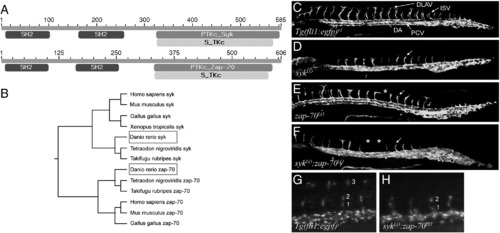Fig. 1
|
The zebrafish orthologs of syk and zap-70 mediate angioblast migration to form the ISVs. (A) Zebrafish syk and zap-70 have similar domain structures with N-terminal SH2 domains, and a C-terminal tyrosine kinase domain (PTK). (B) Alignment of the nucleotide sequences of syk and zap-70 with orthologs in other species shows a clear grouping of zebrafish syk with the other syk orthologs, and zap-70 with the other zap-70 orthologs. (C) At 30 hpf, ISVs in Tg(fli1a:EGFP)y1 embryos have reached the dorsal aspect of the somite and are contributing to the DLAV in wild-type embryos. (D?E) Injection of a low dose of syk morpholino (sykLO, D) or zap-70 morpholino (zap-70LO, E) results in delayed (arrows) or completely suppressed (asterisk) angioblast migration to form the ISVs. (F) Co-injection of low doses of both morpholinos results in a more severe stalling and suppression of angioblast migration (sykLO:zap-70LO). (G?H) Tg(fli1a:EGFP)y7 embryos with endothelial-expressed nuclear GFP show fewer cells in the ISVs of sykLO:zap-70LO embryos. Anterior is to the left in all embryos. DA: dorsal aorta; PCV: posterior cardinal vein; ISV: intersegmental vessel; DLAV: dorsal longitudinal anastomotic vessel; hpf: hours post fertilization. |
| Fish: | |
|---|---|
| Knockdown Reagents: | |
| Observed In: | |
| Stage: | Prim-15 |
Reprinted from Developmental Biology, 340(1), Christie, T.L., Carter, A., Rollins, E.L., and Childs, S.J., Syk and Zap-70 function redundantly to promote angioblast migration, 22-29, Copyright (2010) with permission from Elsevier. Full text @ Dev. Biol.

